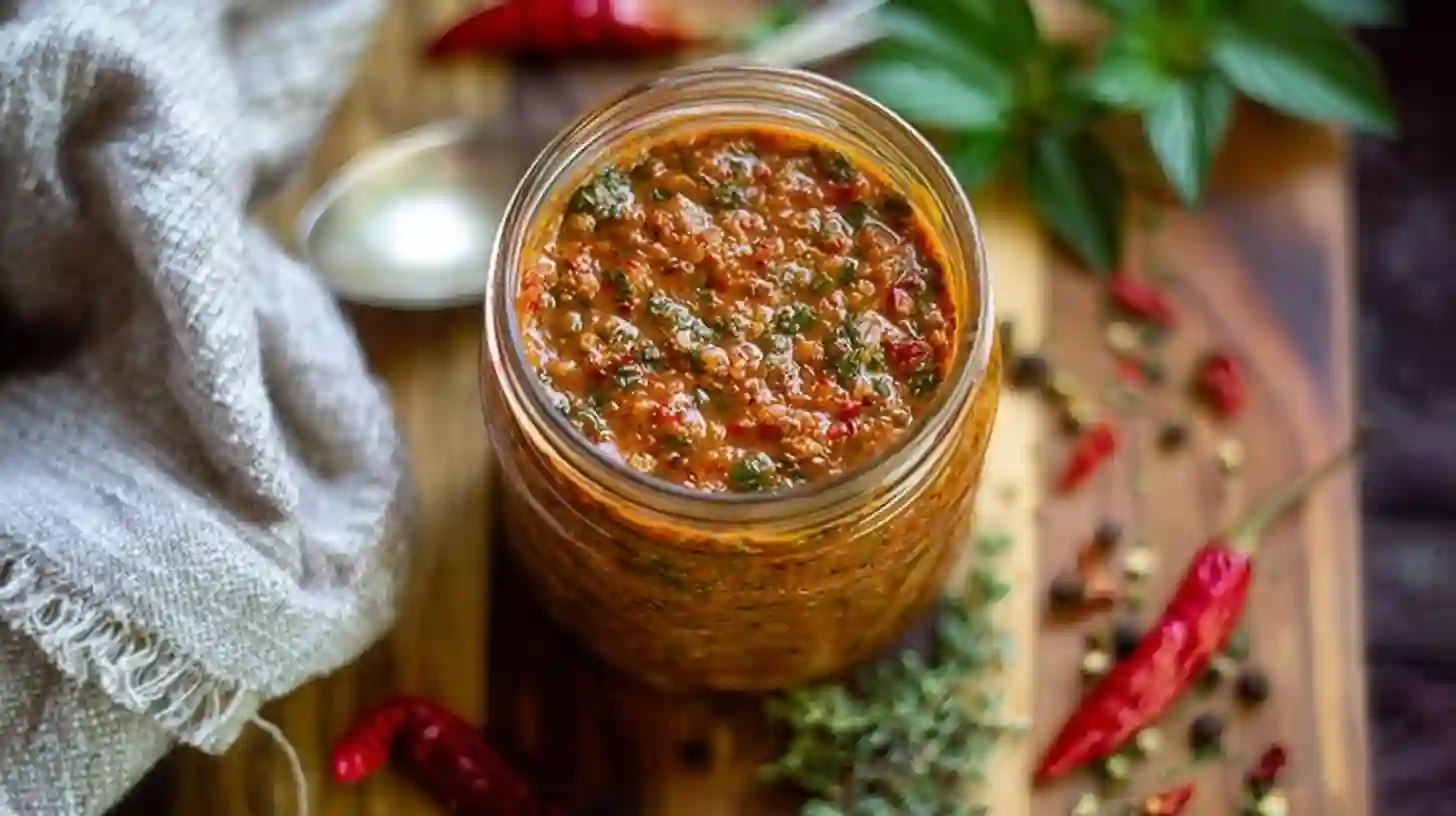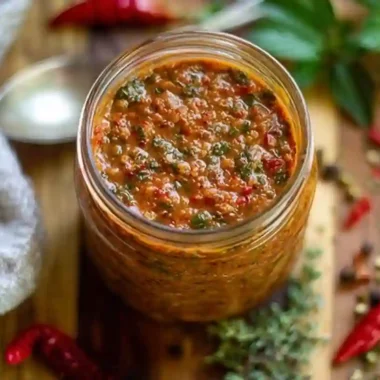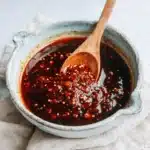Are you a chilihead craving that perfect balance of heat and flavor? Tired of store-bought hot sauces that taste either too bland or way too harsh? This guide is for you. With a few fresh ingredients and a bit of kitchen time, you’ll learn how to make your own vibrant and customizable habanero hot sauce at home.
Inside, you’ll discover everything you need to know. From choosing the right peppers to adjusting the spice level, from blending techniques to safe storage. Whether you’re a heat-seeker or looking for bold flavor with balance, this is the only guide you’ll need to master homemade habanero hot sauce. Grab your gloves and let’s get cooking.
Table of Contents
Habanero Peppers : Your Guide to the Fiery Fruit
Habanero peppers are small but mighty, known for their intense heat and fruity aroma. Originally from the Amazon region and widely grown in Mexico and the Caribbean, they come in several varieties. The most common are orange and red habaneros, while Caribbean red offers even more heat. Scotch Bonnet peppers are close relatives with a similar kick and flavor.
On the Scoville scale, habaneros rank between 100,000 and 350,000 SHU. This heat comes from capsaicin, a natural compound that triggers the spicy burn. Even small amounts pack a punch, so caution is key.
Always wear gloves when handling habaneros. Avoid touching your face, and work in a well-ventilated space. If capsaicin gets on your skin, wash with dish soap and rinse with cold water or apply dairy-based products like milk or yogurt.
For the best sauce results, pick peppers that are fully ripe, firm, and brightly colored. You can find quality habaneros at farmers markets, specialty grocers, or grow your own for peak freshness.
Ingredients Needed for Homemade Habanero Hot Sauce
To create a bold and balanced habanero hot sauce, start with fresh, quality ingredients. Here’s what you’ll need, grouped for clarity:
Core Ingredients
- Habanero peppers, about 8 to 10. Remove seeds for less heat or keep them in for full intensity.
- Distilled white vinegar or apple cider vinegar, 1 cup. Acts as both a flavor enhancer and natural preservative.
- Water, 1 cup. Adjust for desired consistency.
- Salt, 1 teaspoon. Essential for seasoning and preservation.
Aromatics
- Garlic cloves, 3 to 4, peeled. Adds depth and bite.
- Yellow onion, 1 small, diced. Brings sweetness and body.
- Shallot, 1 small, optional. Offers a mild and slightly sweet flavor boost.
Flavor Enhancers
- Carrot, 1 medium, chopped. Adds natural sweetness and thickens the sauce.
- Sweet or smoked paprika, 1 teaspoon. Provides warmth and a hint of smokiness.
- Dried oregano, 1 teaspoon. Lends a subtle herbal layer.
- Ground black pepper, ½ teaspoon. Enhances overall spice complexity.
Optional Boosters
- Lime or orange juice, 1 to 2 tablespoons. Adds brightness and contrast.
- Sugar or maple syrup, 1 teaspoon. Balances acidity and heat.
- Milder peppers like jalapeños or bell peppers. Use to mellow the heat without losing flavor.
These ingredients form the foundation of a sauce that’s fiery, flavorful, and fully customizable to your taste.
How to Make Habanero Hot Sauce: Step-by-Step Instructions
Follow these detailed steps to create a rich and vibrant habanero hot sauce at home. Each stage plays a role in building flavor and achieving the perfect consistency.
1. Prepare Your Ingredients
Start by washing all produce thoroughly. Remove stems from the habanero peppers. If you want less heat, slice them open and scrape out the seeds and inner membranes. Peel the garlic, chop the onion and carrot, and gather the rest of your ingredients.
2. Sauté the Aromatics for More Depth
In a medium saucepan, heat a tablespoon of oil over medium heat. Add the chopped onion and shallot first and cook for about three to four minutes until they soften and turn translucent. Stir in the carrots and cook for another two to three minutes. Add the garlic last and cook just until fragrant. This step deepens the flavor and removes harsh raw notes.
3. Simmer the Main Mixture
Add the habanero peppers to the pot along with vinegar, water, salt, paprika, oregano, and black pepper. Stir everything together and bring the mixture to a gentle boil. Once boiling, reduce the heat and let it simmer uncovered for about 10 to 15 minutes. You’ll know it’s ready when the carrots are soft and the peppers have broken down.

4. Let It Cool Slightly Before Blending
Turn off the heat and allow the mixture to cool for at least five minutes. Blending hot liquids can be dangerous, so this step is essential for safety.
5. Blend Until Smooth and Silky
Transfer the mixture into a blender or use an immersion blender directly in the pot. Blend until smooth. If the sauce is too thick, add a bit more water or vinegar until you reach the desired texture. It should coat the back of a spoon without feeling heavy.

6. Taste and Adjust for Balance
Taste the sauce carefully. Add more salt if needed. If it’s too sharp, a small splash of citrus juice or a touch of sweetness can balance the flavors. For extra heat, blend in another pepper.
7. Bottle and Store Properly
Pour the finished sauce into clean, sterilized bottles or jars. Use a funnel if needed to avoid spills. Seal tightly and refrigerate. The flavor will continue to develop over the next day or two.
This homemade habanero hot sauce delivers bold heat with layers of flavor, ready to use on everything from eggs to tacos.

Mastering the Heat: Customization and Flavor Variations
One of the best parts of making your own habanero hot sauce is the ability to fine-tune the flavor and heat to your liking. Here’s how to personalize your sauce with confidence.
Adjusting the Spice Level
If the sauce turns out too hot, there are a few easy ways to tone it down. Removing the seeds and white membranes from the habaneros can cut the heat significantly since that’s where much of the capsaicin is concentrated.
For a milder blend, you can also mix in other peppers like jalapeños or bell peppers. They soften the intensity without dulling the flavor. On the flip side, if you want to dial up the fire, simply add more habaneros or leave the seeds in.
Exploring Flavor Profiles
To give your sauce a twist, try experimenting with these combinations.
Fruity and Sweet Variations
Add chopped pineapple, mango, peach, or even blueberries for a hint of sweetness and a vibrant flavor layer. Use about a half cup of fruit per batch for balance without overwhelming the sauce.
Smoky Additions
Roast the habaneros in the oven or on a grill before blending. You can also include smoked paprika or a few drops of liquid smoke for a deep, earthy finish.
Tangy and Bright Options
Swap out some vinegar for rice wine or add citrus juices like lime or lemon. These choices lift the overall flavor and help cut through the heat.
Earthy and Savory Twists
Blend in spices such as cumin or extra dried oregano. These ingredients give the sauce a grounded, rich flavor that pairs well with grilled meats or roasted vegetables.
Advanced Techniques in Brief
Fermented Habanero Hot Sauce
Fermenting your peppers before blending can create a more complex and slightly tangy flavor. This process involves letting the chopped peppers sit in a brine at room temperature for several days to develop natural probiotics. If you’re interested in trying it, consider reading a full guide focused on fermentation safety and timing.
Roasting for Extra Depth
Roasting habaneros before cooking mellows the sharpness and adds a touch of sweetness. It also softens the texture, making blending easier.
With these variations, your habanero hot sauce can be as fiery, fruity, or smoky as you like.
Storage and Shelf Life: Keeping Your Homemade Hot Sauce Fresh and Safe
Once your habanero hot sauce is blended and bottled, knowing how to store it properly ensures it stays fresh and safe to enjoy.
Refrigeration is Key
Homemade hot sauce typically lasts two to three months in the refrigerator, thanks to the vinegar. Always store it in a sealed glass jar or bottle and keep it chilled after opening. Avoid plastic containers, as they may absorb the strong aromas and color over time.
Understanding pH and Shelf Stability
For a sauce to be shelf-stable without refrigeration, it needs a pH of less than 4.0. This level helps prevent bacterial growth. You can check this using affordable pH strips or a digital pH meter. If you’re not measuring pH, always keep the sauce refrigerated to be safe.
Canning or Water Bath Method
If you are experienced in safe canning methods, you can preserve hot sauce for longer storage. This involves sterilizing jars, sealing them tightly, and boiling them in water for the correct time. If you’re not an expert in food preservation, it’s best to avoid guessing. Refer to trusted sources like USDA guidelines or university extension services for proper techniques. Precision in pH levels and heat processing is critical to avoid health risks.
Freezing Your Sauce
For long-term storage without canning, freezing is a great option. Pour the sauce into silicone ice cube trays and freeze. Once solid, transfer the cubes to a freezer-safe bag. Thaw as needed. Note that freezing may slightly change the texture. A quick blend after thawing can bring it back to a smoother consistency.
With proper storage, your homemade hot sauce will be safe, flavorful, and ready whenever you need a spicy kick.
Troubleshooting Common Habanero Hot Sauce Problems
Every cook runs into a few bumps when making hot sauce. Here are common issues and how to fix them quickly and easily.
My Sauce Is Too Thick or Too Thin
If your sauce is too thick, try adding a splash of water or vinegar and blend again until it reaches your preferred consistency. For sauce that’s too runny, return it to the pan and simmer it uncovered for five to ten minutes to let excess liquid evaporate.
Why Does My Sauce Taste Bitter
Bitterness often comes from including too many seeds or pith. To avoid this, remove most of the seeds and white membranes before blending. You can also balance the flavor by adding a bit of sugar, maple syrup, or citrus juice.
My Sauce Separated After Sitting
Separation is natural in homemade sauces with no preservatives. Simply shake the bottle before each use. For a more stable sauce, blend longer or add a touch of olive oil to help emulsify the ingredients.
The Sauce Is Way Too Hot
Too much heat? You’re not alone. Try mixing in more carrot, bell pepper, or even a bit of fruit like mango to dilute the intensity. When serving, pairing the sauce with creamy sides like sour cream or yogurt can tone things down without changing the sauce itself.
It’s Not Hot Enough for Me
Want a stronger kick? Use more habaneros or switch to a hotter variety like Caribbean red. Including the seeds and membranes can also boost the spice level. Just be sure to taste as you go so you don’t go overboard.
With these simple solutions, you can fix most issues and still end up with a flavorful, fiery sauce that fits your taste.
Creative Ways to Use Your Homemade Habanero Hot Sauce
Your homemade habanero hot sauce is more than just a condiment. With its bold heat and complex flavor, it can elevate a wide range of dishes. Here are some creative and tasty ways to use it.
As a Condiment
Drizzle it over tacos, burritos, scrambled eggs, or avocado toast. A little goes a long way, but the burst of flavor is worth it.
Mixed Into Sauces and Dressings
Add a spoonful to mayonnaise or Greek yogurt to create a spicy dip or sandwich spread. Mix it into vinaigrettes to give your salads a punchy edge.
With Roasted or Grilled Vegetables
Toss roasted cauliflower, carrots, or sweet potatoes with a bit of the sauce right before serving. It adds color and heat without overpowering the natural flavors.
As a Marinade Ingredient
Combine it with olive oil, garlic, and lime juice to marinate chicken, shrimp, or steak. The acidity tenderizes the meat while the habanero brings the heat.
In Soups and Stews
Stir in a small amount to give your chili, lentil soup, or chicken stew an extra layer of spice. It blends well with broth-based and tomato-based dishes alike.
On Popcorn or Cauliflower Wings
Lightly toss popcorn with melted butter and a few drops of hot sauce. Or coat crispy cauliflower bites with it for a fiery plant-based snack.
Unexpected but Delicious Uses
Try a dash in chocolate-based recipes like spicy brownies or hot cocoa. Use it in cocktails like a spicy margarita or Bloody Mary for a memorable kick.
With a bottle of homemade habanero hot sauce in your fridge, the flavor possibilities are endless.

The Ultimate Homemade Hot Sauce Recipe
Ingredients
Method
- Rinse the peppers, herbs, and garlic. Remove stems from the hot peppers and the bell pepper. Remove seeds and white ribs from the hot peppers if you want a milder sauce.
- Place all ingredients in a food processor or high-speed blender: hot peppers, bell pepper, garlic, salt, vinegar, olive oil, cilantro, and mint. Blend until the mixture is chunky but well combined. Do not over-blend if you prefer texture.
- Spoon the mixture into a clean mason jar. Use a spatula to scrape down the sides and pack the sauce evenly into the container.
- Pour a thin layer of olive oil over the top of the sauce to help preserve freshness.
- Seal the jar tightly and refrigerate for at least 24 hours before using to allow the flavors to develop.
- Use your homemade hot sauce to spice up meals or give as a gift. Store in the refrigerator for up to three months.
Notes
Nutrition Facts (Per Serving)
- Calories: 23
- Calories from Fat: 18
- Total Fat: 2g (3% DV)
- Saturated Fat: 1g (6% DV)
- Sodium: 234mg (10% DV)
- Potassium: 53mg (2% DV)
- Carbohydrates: 2g (1% DV)
- Fiber: 1g (4% DV)
- Sugar: 1g (1% DV)
- Protein: 1g (2% DV)
- Vitamin A: 171IU (3% DV)
- Vitamin C: 22mg (27% DV)
- Calcium: 4mg (0% DV)
Why This Habanero Hot Sauce Recipe Is a Must-Try
This habanero hot sauce recipe delivers more than just heat. It offers bold flavor, natural ingredients, and the flexibility to make it exactly how you like it. Whether you enjoy your sauce fiery and intense or balanced with a fruity twist, this guide walks you through every step with clarity and confidence.
Homemade means fresher taste, no unnecessary additives, and full control over spice levels. You’ll not only impress your taste buds but also your friends and family. Plus, it keeps well in the fridge, making it a ready-to-go flavor boost for any meal.
If you tried this recipe, leave a comment and give it a star rating. Let us know what variation you made or how you used your sauce. Did you go smoky, sweet, or tropical?
Don’t forget to share your hot sauce photos on social media. Tag it for others to discover. Spicy food lovers everywhere will thank you.
Want to try a different style? Visit our Hot Sauce Recipe post for more spicy creations.
Frequently Asked Questions
Here are answers to some of the most common questions about making habanero hot sauce at home.
How do you make hot sauce with habanero peppers?
Start by chopping fresh habanero peppers and cooking them with vinegar, garlic, onion, and other flavor boosters like carrot or spices. Blend the cooked mixture until smooth, adjust seasoning to taste, and store in sterilized bottles. Full instructions are detailed in the step-by-step section above.
Are habaneros good for hot sauce?
Yes, habaneros are excellent for hot sauce. They offer intense heat along with a fruity, floral flavor that pairs well with sweet, tangy, and smoky ingredients.
How do you make hot sauce with habanero peppers?
Start by chopping fresh habanero peppers and cooking them with vinegar, garlic, onion, and other flavor boosters like carrot or spices. Blend the cooked mixture until smooth, adjust seasoning to taste, and store in sterilized bottles. Full instructions are detailed in the step-by-step section above.
Are habaneros good for hot sauce?
Yes, habaneros are excellent for hot sauce. They offer intense heat along with a fruity, floral flavor that pairs well with sweet, tangy, and smoky ingredients.
How long to ferment habanero hot sauce?
Fermentation usually takes five to seven days, depending on room temperature and personal taste. The process adds depth and complexity. Always use clean jars and a proper salt brine for safety.
Can I use dried habaneros?
Yes, but rehydrate them first in warm water for about 15 to 20 minutes. Dried habaneros have a more concentrated flavor and may alter the sauce’s texture and color slightly.
What’s the best blender for hot sauce?
A high-speed blender such as Vitamix or NutriBullet works best for smooth consistency. An immersion blender is a good alternative for smaller batches or less cleanup.









